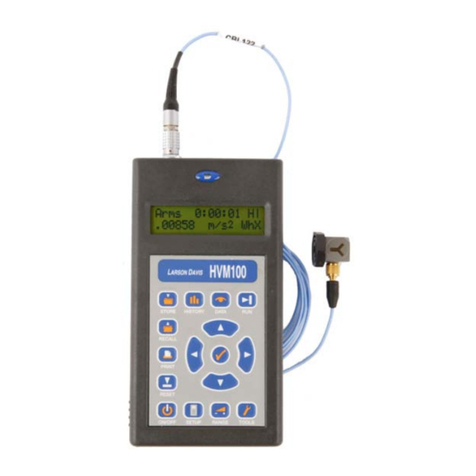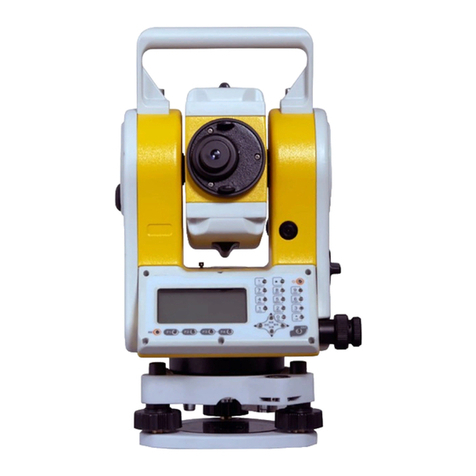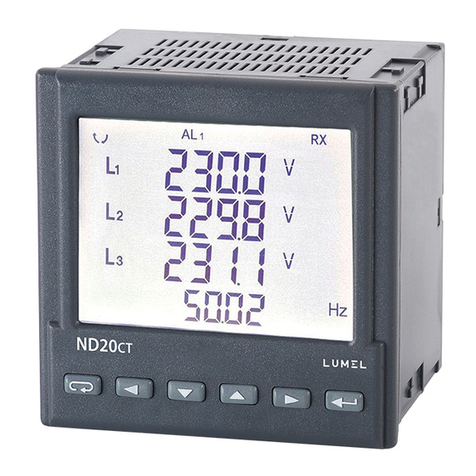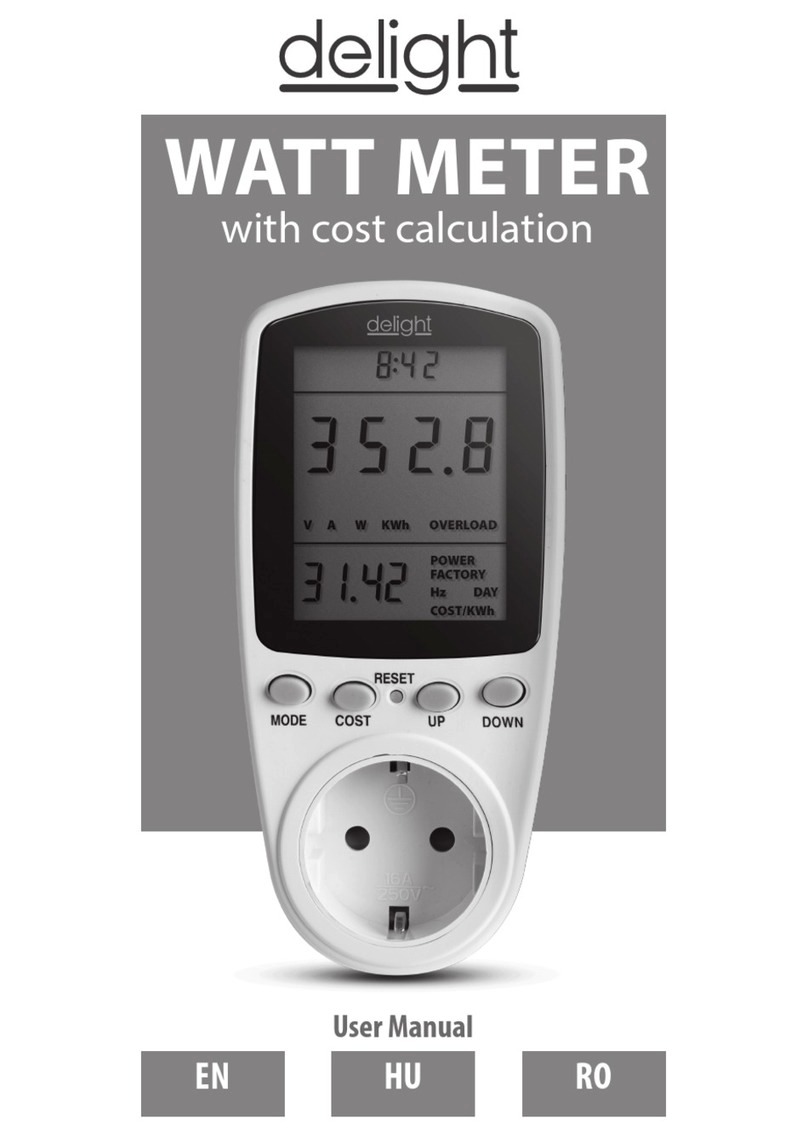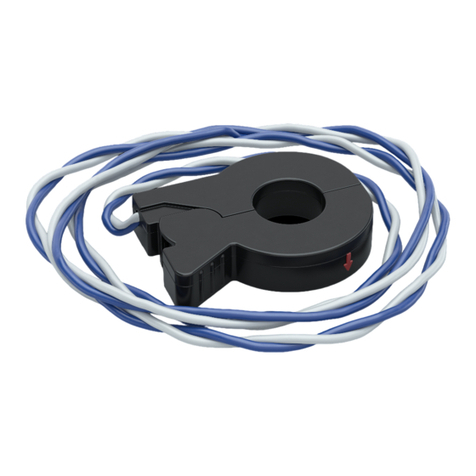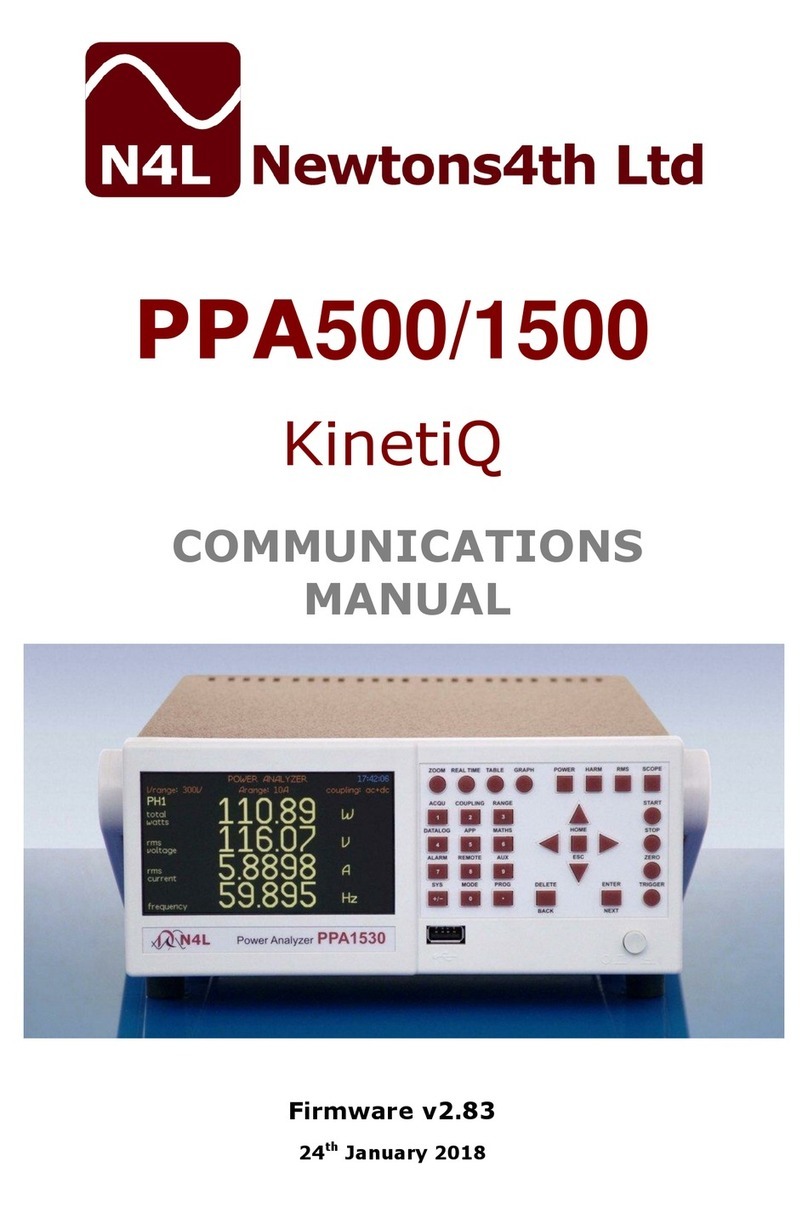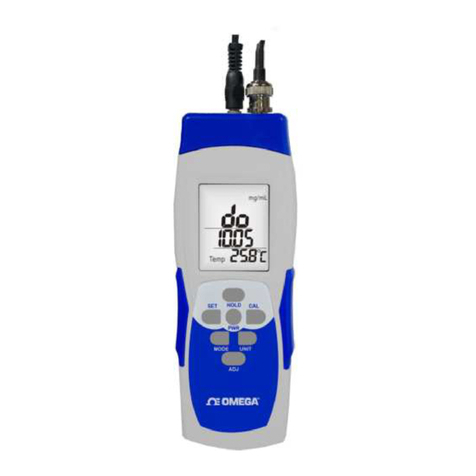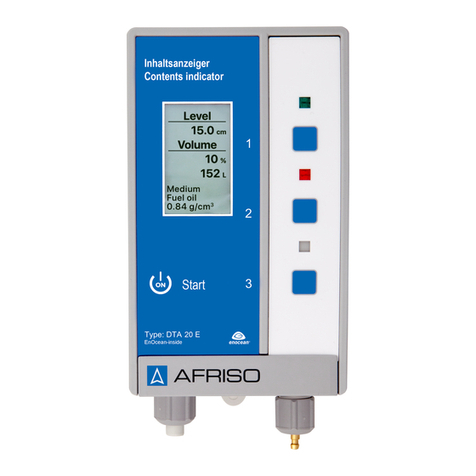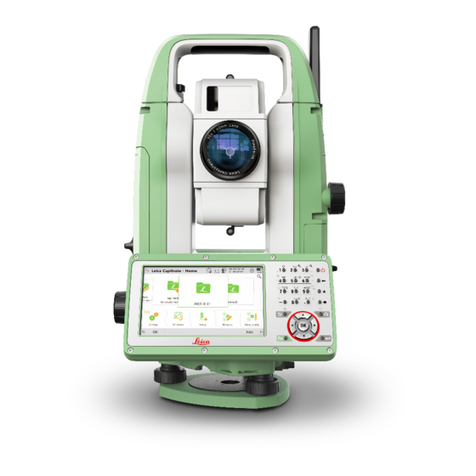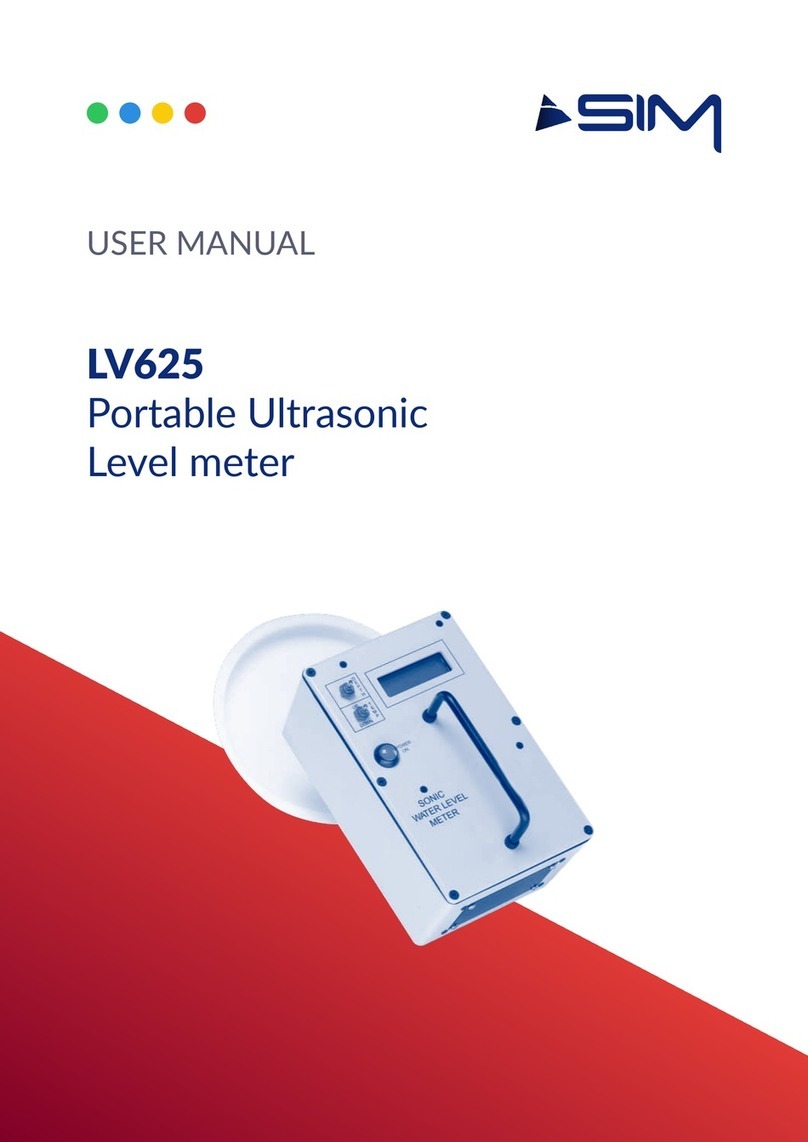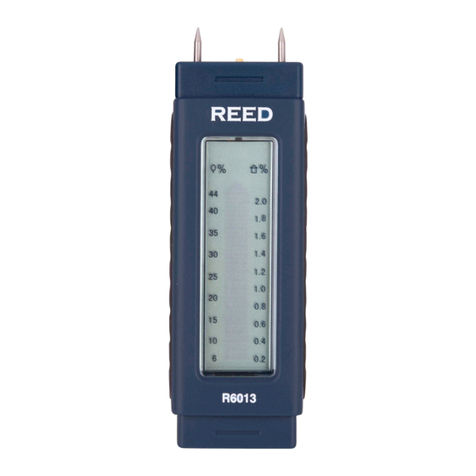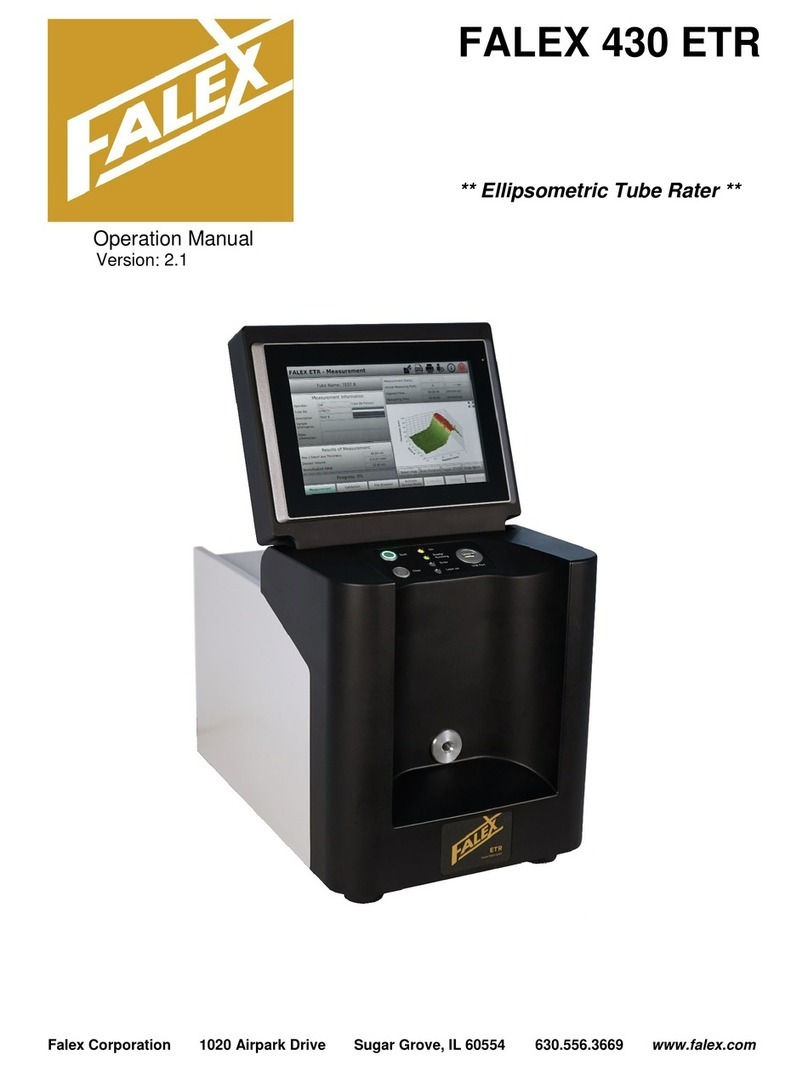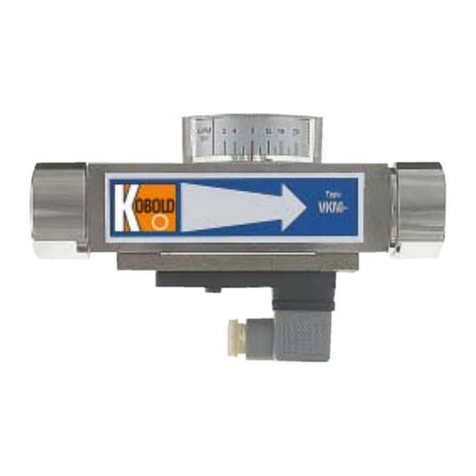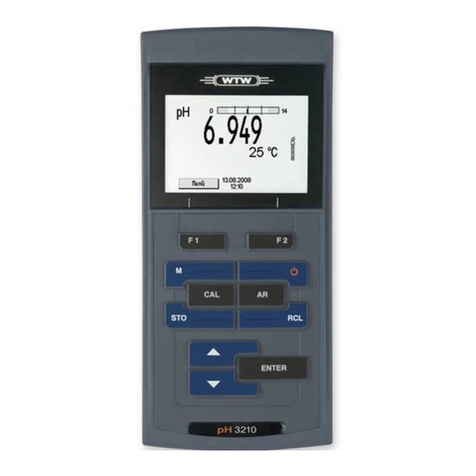GLI International Accu4 Instruction Manual

Rev. 2-300 Accu4™ Low-range Turbidimeter System
1
OPERATING INSTRUCTION MANUAL
Accu4™
Low-range
Turbidimeter System
(Model T53 Analyzer and 8320 Sensor)
Worldwide Headquarters and Sales:
GLI International, Inc.
9020 West Dean Road
Milwaukee, Wisconsin 53224
U.S.A.
Represented By:
In the interest of improving and updating its equipment, GLI reserves the right to alter specifications to equipment at any time.
A company
Viridor Instrumentation
Phone:
Fax:
E-mail:
Web:
[414] 355-3601
[414] 355-8346
info@gliint.com
www.gliint.com

Accu4™Low-range Turbidimeter System Rev. 2-300
2

Rev. 2-300 Accu4™Low-range Turbidimeter System
3
IMPORTANT SAFETY INFORMATION
This measurement system is compliant with safety standards as outlined in:
FMRC Class Numbers 3600, 3611, and 3810 (U.S.A.)
CSA C22.2 No. 142 and C22.2 No. 213 (Canada)
EN 61010-1 (European Community)
Please read and observe the following:
•Opening the analyzer door exposes you to line power voltage, if present, at terminals on TB2 and TB3
inside the enclosure. This may be hazardous. Always remove line power before entering this area in
the analyzer. However, the analyzer door assembly and the sensor contain only low voltages and are
completely safe to handle.
•Wiring or repairs should only be performed by qualified personnel and only to an unpowered analyzer.
•Whenever it appears that analyzer safety is questionable, disable the analyzer to ensure against any
unintended operation. For example, an unsafe condition is likely when:
1) The analyzer appears visibly damaged.
2) The analyzer fails to operate properly or provide the intended measurements.
3) The analyzer has been stored for long periods at temperatures above 158°F (70°C).
•This measurement system must be installed by specially trained personnel in accordance with relevant
local codes and instructions contained in this operating instruction manual. Observe all technical
specifications of the system. If one line of the line power mains is not neutral, use a double-pole mains
switch to disconnect the analyzer.
HELPFUL IDENTIFIERS
In addition to information on installation and operation, this instruction manual may contain
WARNINGS pertaining to user safety, CAUTIONS regarding possible instrument malfunction, and
NOTES on important, useful operating guidelines.
WARNING:
A WARNING LOOKS LIKE THIS. IT WARNS YOU OF THE POTENTIAL
FOR PERSONAL INJURY.
CAUTION:
A CAUTION LOOKS LIKE THIS. IT ALERTS YOU TO POSSIBLE
INSTRUMENT MALFUNCTION OR DAMAGE.
☞
NOTE: A note looks like this. It alerts you to important operating
information.

Accu4™Low-range Turbidimeter System Rev. 2-300
4
Definition of Equipment Symbols
This symbol means CAUTION and alerts you to possible danger or
instrument malfunction. Refer to this manual before proceeding.
This symbol means that this is a protective ground terminal and
alerts you to connect an earth ground to it.
This symbol means that there is alternating current present and
alerts you to be careful.
WARRANTY
GLI International, Inc. warrants the Accu4™Low-range Turbidimeter System to be free
from defects in material or workmanship for a period of 2 years (24 months) from the
date this product was shipped from our facility. A warranty claim will not be honored if
defects are not reported within the warranty period, or if GLI International determines that
defects or damages are due to normal wear, misapplication, lack of maintenance, abuse,
improper installation, alteration, or abnormal conditions. GLI International’s obligation
under this warranty shall be limited to, at its option, replacement or repair of this product.
The product must be returned to GLI International, freight prepaid, for examination. The
product must be thoroughly cleaned and any process chemicals removed before it will be
accepted for replacement or repair. GLI International’s liability shall not exceed the cost
of the product. Under no circumstances will GLI International be liable for any incidental
or consequential damages, whether to person or property. GLI International will not be li-
able for any other loss, damage or expense of any kind, including loss of profits,
resulting from the installation, use, or inability to use this product.

Rev. 2-300 Accu4™Low-range Turbidimeter System
5
CONDENSED OPERATING INSTRUCTIONS
This manual contains details for all operating aspects of the Accu4™Low-range Turbidimeter System.
The following condensed instructions are provided to assist you in getting the system started up and op-
erating as quickly as possible. These condensed instructions only pertain to basic turbidity
measurement operation. To use specific analyzer features, refer to the appropriate sections in this
manual for instructions.
1. CONNECTING SENSOR
After the T53 analyzer is properly mounted (Part Two, Section 2.5), connect the GLI Model 8320 low-
range turbidity sensor, matching wire colors to terminals as indicated:
Sensor Wire
Colors
Analyzers with
“B”Prefix Serial No.
Analyzers with
No Letter Prefix Serial No.
Inner Shield Grounding strip lug Terminal #11 on TB1
Red Terminal #12 on TB1 Terminal #12 on TB1
Violet Terminal #13 on TB1 Terminal #13 on TB1
Green Terminal #14 on TB1 Terminal #14 on TB1
White Terminal #15 on TB1 Terminal #15 on TB1
Yellow Terminal #16 on TB1 Terminal #16 on TB1
Inner Shield Grounding strip lug Terminal #17 on TB1
Brown Terminal #18 on TB1 Terminal #18 on TB1
Gray Terminal #19 on TB1 Terminal #19 on TB1
Blue Terminal #20 on TB1 Terminal #20 on TB1
Black Terminal #21 on TB1 Terminal #21 on TB1
Orange Terminal #22 on TB1 Terminal #22 on TB1
2. CONNECTING LINE POWER
Important: Follow the instructions in Part Two, Section 3.5 to connect line power to the analyzer.
3. ADJUSTING DISPLAY CONTRAST
Ambient lighting conditions may make it necessary to adjust display contrast to improve visibility.
With the MEASURE screen displayed, press and hold the ENTER key and simultaneously press the
×
×
or
Ø
Ø
key until attaining the desired contrast.
4. CALIBRATING SYSTEM
Always initially calibrate the Accu4™Low-range Turbidimeter System to ensure accurate meas-
urement. Any time thereafter, you can conveniently check system calibration using an optional
accessory Cal-CubeTM assembly.
•When you need to calibrate with a
primary standard, use the “PRIMARY CAL”calibration
method. GLI only guarantees measurement accuracy when a 40 NTU formazin suspension is used
as the primary standard.
•When calibration need not conform to USEPA requirements, use the “CUBE CAL”calibration
method (requires optional GLI CAL-CUBE™assembly) or the “SAMPLE CAL”method.
Refer to Part Three, Section 5 for instructions on all calibration methods.
5. COMPLETING ANALYZER CONFIGURATION
To further configure the analyzer to your application requirements, use the appropriate CONFIGURE
screens to make selections and “key in”values. Refer to Part Three, Section 4 for complete configu-
ration details.

Accu4™Low-range Turbidimeter System Rev. 2-300
6

Rev. 2-300 Accu4™Low-range Turbidimeter System
7
TABLE OF CONTENTS
PART ONE - INTRODUCTION
SECTION 1 GENERAL INFORMATION
1.1 Capability Highlights ........................................................................13-15
1.2 Modular Construction ............................................................................15
1.3 Retained Configuration Values .............................................................15
1.4 Analyzer and Sensor Serial Numbers ...................................................15
1.5 EMI/RFI Immunity..................................................................................16
SECTION 2 SPECIFICATIONS....................................................................................17-18
PART TWO - INSTALLATION
SECTION 1 UNPACKING.................................................................................................19
SECTION 2 MECHANICAL REQUIREMENTS
2.1 Sensor Location ...............................................................................19-20
2.2 Sensor Mounting ..............................................................................20-21
2.3 Sensor Plumbing Connections ..............................................................22
2.4 Analyzer Location..................................................................................23
2.5 Analyzer Mounting............................................................................23-24
2.6 Sensor and Analyzer Conduit Hole Requirements................................24
SECTION 3 ELECTRICAL CONNECTIONS
3.1 GLI Model 8320 Low-range Turbidity Sensor...................................25-27
3.2 Analog Outputs......................................................................................28
3.3 Relay Outputs...................................................................................28-29
3.4 Closed Contact TTL Input .....................................................................29
3.5 Line Power .......................................................................................30-31
PART THREE - OPERATION
SECTION 1 USER INTERFACE
1.1 Display ..................................................................................................32
1.2 Keypad .............................................................................................32-33
1.3 MEASURE Screen (normal display mode)............................................34
SECTION 2 MENU STRUCTURE
2.1 Displaying Main Branch Selection Screen ............................................35
2.2 Displaying Top-level Menu Screens.................................................35-36
2.3 Displaying Submenu Screens ...............................................................36
2.4 Adjusting Edit/Selection Screen Values ...........................................36-37
2.5 Entering (Storing) Edit/Selection Screen Values/Choices.....................37

Accu4™Low-range Turbidimeter System Rev. 2-300
8
TABLE OF CONTENTS (continued)
SECTION 3 ADJUSTING DISPLAY CONTRAST.............................................................37
SECTION 4 CONFIGURING THE ANALYZER
4.1 Selecting LANGUAGE to Operate Analyzer..........................................38
4.2 Configuring Sensor Characteristics:
SELECT UNITS ..........................................................................38-39
SET FILTER Time............................................................................39
Select PULSE SUPPRESS (on/off)..................................................40
ENTER NOTE (top line of MEASURE screen).................................40
4.3 Configuring Analog Outputs (1 and 2):
SET 0/4 and 20 mA VALUES......................................................41-42
SET TRANSFER Value (mA) ...........................................................42
SET FILTER Time............................................................................43
Select SCALE 0 mA/4 mA (low endpoint) ........................................43
4.4 Configuring Relays (A, B, C, and D):
SET FUNCTION Mode (alarm, control, or status).......................44-45
SET TRANSFER Mode (relay on or off) ..........................................46
SET ACTIVATION (configuration values) ...................................46-48
4.5 SET PASSCODE (feature enabled or disabled) ...................................48
4.6 Configuration Settings Summary (ranges/choices and defaults) ..........49
SECTION 5 CALIBRATING THE ANALYZER
5.1 Things to Know About Calibration....................................................50-51
5.2 PRIMARY CAL Method (requires formazin suspension):
Preparing Formazin Solution ......................................................51-52
Filling Sensor..............................................................................52-54
Entering Value .................................................................................54
Resuming Operation ...................................................................54-55
5.3 CUBE CAL Method (requires optional Cal-CubeTM assembly):
Inserting Cal-CubeTM Assembly ..................................................55-56
Entering Value ............................................................................56-57
Resuming Operation ........................................................................57
5.4 SAMPLE CAL Method (requires sample with value
determined by laboratory analysis or portable meter)......................57-59
5.5 Analog Outputs (1 and 2) Calibration...............................................59-60
SECTION 6 TEST/MAINTENANCE
6.1 STATUS Checking (analyzer, sensor, and relays)...........................61-63
6.2 CHECK CAL/HOLD Outputs ............................................................63-64
6.3 OVERFEED RESET (relay timers) ........................................................65
6.4 OUTPUT (1 and 2) Analog Test Signals ..........................................65-66
6.5 RELAY (A, B, C, and D) Operating Test................................................66
6.6 SENSOR TYPE Checking ................................................................66-67
6.7 EPROM VERSION Checking ................................................................67

Rev. 2-300 Accu4™Low-range Turbidimeter System
9
TABLE OF CONTENTS (continued)
6.8 SIM SENSOR Setting.......................................................................67-68
6.9 RESET DEFAULTS............................................................................... 68
SECTION 7 RELAY OVERFEED TIMER FEATURE
7.1 Why Use an Overfeed Timer.................................................................69
7.2 Configuring Relay Overfeed Timers......................................................69
7.3 Overfeed Timer “Timeout”Operation ....................................................69
7.4 Resetting Overfeed Timers ...................................................................69
7.5 Interactions with Other Analyzer Functions......................................69-70
SECTION 8 HART OPTION
8.1 Introduction ...........................................................................................71
8.2 Analyzer Operating Modes for HART Network.................................72-73
8.3 SINGLE MODE (Point-to-Point) Wiring Arrangement ...........................73
8.4 MULTI-DROP Wiring Arrangement.......................................................74
8.5 HART Preferences Setup:
Changing Polling Address ...............................................................75
Viewing Number of Required Preambles ....................................75-76
8.6 Device Preferences Setup:
Viewing Final Assembly Number .....................................................76
Viewing Model Number ...............................................................76-77
Viewing Manufacturer ......................................................................77
Assigning a Tag ...............................................................................77
Assigning a Descriptor.....................................................................78
Assigning a Message.......................................................................78
Assigning User-defined Date ......................................................78-79
Viewing Identification (ID) ................................................................79
Viewing Revisions............................................................................79
8.7 “Master Reset”Function........................................................................80
8.8 “Refresh”Function ................................................................................80
8.9 Protocol Command Set for PC Programming........................................80
PART FOUR - SERVICE AND MAINTENANCE
SECTION 1 GENERAL INFORMATION
1.1 Cleaning Sensor Flow Chamber ......................................................81-82
1.2 Cleaning Optional Cal-CubeTM Assembly..............................................82
1.3 Replacing Sensor Light Source or Detector:
Removing Inoperative Part ..............................................................83
Installing New Part ......................................................................83-84
Re-calibrating Measurement System...............................................84
1.4 Replacing Fuse(s) ................................................................................. 85
1.5 Replacing Relays ..................................................................................85
1.6 Inspecting Sensor Cable .......................................................................85

Accu4™Low-range Turbidimeter System Rev. 2-300
10
TABLE OF CONTENTS (continued)
SECTION 2 PRESERVING MEASUREMENT ACCURACY
2.1 Eliminating Bubbles in Sensor Flow Chamber:
Restricting Sensor Outlet.................................................................86
Using an External Bubble Trap ........................................................86
2.2 Keeping Sensor Flow Chamber Clean ..................................................87
2.3 Keeping System Calibrated...................................................................87
2.4 Avoiding Electrical Interference.............................................................87
SECTION 3 TROUBLESHOOTING
3.1 System Diagnostic Condition Messages ...............................................88
3.2 Isolating the Problem:
Checking Electrical Connections .....................................................89
Checking Operation Using System Diagnostics .............................. 89
SECTION 4 ANALYZER REPAIR/RETURN
4.1 Customer Assistance.............................................................................90
4.2 Repair/Return Policy .............................................................................90
PART FIVE - SPARE PARTS AND ACCESSORIES
.................................................................................................................91

Rev. 2-300 Accu4™Low-range Turbidimeter System
11
TABLE OF CONTENTS (continued)
ILLUSTRATIONS
Figure 1-1 EMI/RFI Immunity Diagram ..................................................................................................16
Figure 2-1 Recommended Closed-loop Sensor Piping Arrangement......................................................19
Figure 2-2 Recommended Sample Bypass Line Sensor Piping Arrangement ........................................20
Figure 2-3 Standard Design Model 8320 Sensor -- Installation Dimension Details..................................21
Figure 2-4 High Pressure Design Model 8320 Sensor -- Installation Dimension Details..........................21
Figure 2-5 Sampling Point Guidelines for Process Pipe Plumbing Connection.......................................22
Figure 2-6 Analyzer Mounting Arrangements .........................................................................................23
Figure 2-7 Analyzer Installation Dimension Details ................................................................................24
Figure 2-8 Terminal Block Designations for Analyzers with “B”Prefix Serial Number.............................26
Figure 2-9 Terminal Block Designations for Analyzers with No Letter Prefix Serial Number...................26
Figure 2-10 Connecting Model 8320 Low-range Turbidity Sensor to
Analyzers with “B”Prefix Serial Number ...............................................................................27
Figure 2-11 Connecting Model 8320 Low-range Turbidity Sensor to
Analyzers with No Letter Prefix Serial Number .....................................................................27
Figure 2-12 Connecting Control/Alarm Device(s) to Electromechanical Relay(s) .....................................29
Figure 2-13 Connecting 115 V Single Phase to Analyzers with “B”Prefix Serial Number.........................30
Figure 2-14 Connecting 115 V Single Phase to Analyzers with No Letter Prefix Serial Number ...............30
Figure 2-15 Connecting 230 V Single Phase to Analyzers with “B”Prefix Serial Number.........................31
Figure 2-16 Connecting 230 V Single Phase to Analyzers with No Letter Prefix Serial Number ...............31
Figure 2-17 Connecting 230 V Split Phase to Analyzers with “B”Prefix Serial Number............................31
Figure 2-18 Connecting 230 V Split Phase to Analyzers with No Letter Prefix Serial Number ..................31
Figure 3-1 Analyzer Keypad ..................................................................................................................33
Figure 3-2 Location of SINGLE MODE/MULTI-DROP Switch (HART-equipped analyzers only).............73
Figure 3-3 HART SINGLE MODE (Point-to-Point) Wiring Arrangement (for single analyzer) .................73
Figure 3-4 HART MULTI-DROP Wiring Arrangement (for multiple analyzer network) ............................74
Figure 4-1 Standard Design Sensor -- Component Details.....................................................................81
Figure 4-2 High Pressure Design Sensor -- Component Details .............................................................82
Figure 4-3 Turbidity Sensor Terminal Block Designations ......................................................................84
TABLES
Table A Relay Configuration Settings ...........................................................................................46-47
Table B Analyzer Configuration Settings (Ranges/Choices and Defaults) ..........................................49
Table C Relay Overfeed Timer Interactions with Other Analyzer Functions........................................70
Table D System Diagnostic Condition Status Screens/Meanings........................................................88

Accu4™Low-range Turbidimeter System Rev. 2-300
12

PART ONE - INTRODUCTION SECTION 1 - GENERAL INFORMATION
Rev. 2-300 Accu4™Low-range Turbidimeter System
13
PART ONE - INTRODUCTION
SECTION 1
1.1 Capability Highlights
High Accuracy with
Minimal Maintenance
MEASURE Screen
Passcode-protected
Access
Calibration Methods
The Accu4™Low-range Turbidimeter System employs a
technologically-advanced sensor to provide high measure-
ment accuracy and stability, while reducing maintenance
requirements. It is designed to meet the International Stan-
dards For Measurement of Turbidity [ISO 7027-1984(E)]
and USEPA-approved GLI Method 2. This system has an
auto-ranging measuring scale, enabling continuous moni-
toring over a 0.000-100.0 NTU range with automatic
decimal point positioning. The Accu4™Low-range Turbi-
dimeter System automatically provides increasing
display resolution as measured turbidity decreases. To
further ensure high measuring accuracy, the Model 8320
sensor eliminates air or gas bubbles in the sample with its
built-in bubble trap. The system is ideal for critical monitor-
ing and controlling applications including potable water,
filtered water, and final product clarity.
With the display in the normal MEASURE screen mode, the
measured turbidity is always shown on the main middle line.
The bottom auxiliary display line, shown in reverse video,
can be changed by pressing the
Ø
Ø
and
×
×
keys to show
these measurements:
•Analog Output 1 value (mA)
•Analog Output 2 value (mA)
For security, you can enable a passcode feature to restrict
access to configuration and calibration settings to author-
ized personnel only. See Part Three, Section 4.5 for details.
Three methods are available to calibrate the system. See
Part Three, Section 5.1 for details. With the optional Cal-
Cube™assembly, you can conveniently check calibra-
tion any time (Section 6.2). The mA value for each analog
output can also be calibrated (Section 5.5).
GENERAL INFORMATION

PART ONE - INTRODUCTION SECTION 1 - GENERAL INFORMATION
Accu4™Low-range Turbidimeter System Rev. 2-300
14
Analog Outputs
Relays
☞
The analyzer provides two isolated analog outputs (1 and
2). Each output represents the measured turbidity, and can
be set to be 0-20 mA or 4-20 mA.
Turbidity values can be entered to define endpoints at which
the minimum and maximum analog output values are desired.
During calibration, both analog outputs can be selected to:
•Hold their present values (HOLD OUTPUTS).
•Transfer to preset values to operate control elements by an
amount corresponding to those values (XFER OUTPUTS).
•Remain active to respond to the measured turbidity
(ACTIVE OUTPUTS).
For complete analog output setup details, including transfer
setup, refer to Part Three, Section 4.3.
The analyzer has four electromechanical relays with SPDT
contacts. Each relay can be set to function as a CONTROL,
ALARM (dual-alarm), or STATUS relay. CONTROL and
ALARM relays operate in response to the measured turbid-
ity. STATUS relays operate only in response to selected
system diagnostic conditions.
NOTE: Relay D is factory-set to function as a STATUS re-
lay but can be configured as a CONTROL or
ALARM relay.
When a relay is set to function as a STATUS relay, it be-
comes a dedicated system diagnostic-only alarm relay. A
STATUS relay can be configured for:
•FAIL mode -- sets STATUS relay to activate when there
is a FAIL condition (analyzer, light source or detector) or
a sensor CHAMBER UNKNOWN condition.
•WARN mode -- sets STATUS relay to activate only when
there is a sensor flow CHAMBER DIRTY condition.
•ALL mode -- sets STATUS relay to activate when there
is any abnormal system condition (any FAIL condition,
or sensor CHAMBER DIRTY or UNKNOWN condition).
A “WARNING CHECK STATUS”message automatically
flashes on the MEASURE screen whenever the analyzer
detects any of these system diagnostic conditions:

PART ONE - INTRODUCTION SECTION 1 - GENERAL INFORMATION
Rev. 2-300 Accu4™Low-range Turbidimeter System
15
1.2 Modular Construction
1.3 Retained
Configuration Values
1.4 Analyzer and Sensor
Serial Numbers
•ANALYZER FAIL •SOURCE 2 FAIL
•CHAMBER DIRTY •DETECT 1 FAIL
•CHAMBER UNKNOWN •DETECT 2 FAIL
•SOURCE 1 FAIL
To determine the condition causing the warning message,
display the “STATUS screens”in the TEST/MAINT menu
branch. For more details, refer to Part Three, Section 6.1.
During calibration, CONTROL and ALARM relay on/off
states are affected in the same way as the analog outputs
by the “(HOLD/XFER/ACTIVE) OUTPUTS”screen selec-
tion. These relays are also held at their present on/off
states, transferred to desired preset on/off states, or remain
active to respond to measured turbidity. For complete relay
setup details, including transfer setup, see Part Three, Sec-
tion 4.4.
The modular construction of the analyzer simplifies field
servicing and provides electrical safety. The front door/
keypad assembly and the sensor use voltages no greater
than 24 VDC, and are completely safe to handle.
Opening the analyzer door accesses terminals inside the
enclosure for electrical connections. Line power must be
connected to specifically designated terminals on TB3.
WARNING:
REMOVE LINE POWER BEFORE NEARING THIS AREA
TO AVOID ELECTRICAL SHOCK.
All user-entered configuration values are retained indefi-
nitely, even if power is lost or turned off. The non-volatile
analyzer memory does not require battery backup.
A label with the analyzer model number, serial number,
build date, and other items is affixed to the top of the ana-
lyzer enclosure. A similar label is affixed to the sensor.

PART ONE - INTRODUCTION SECTION 1 - GENERAL INFORMATION
Accu4™Low-range Turbidimeter System Rev. 2-300
16
1.5 EMI/RFI Immunity The analyzer is designed to provide protection from most
normally encountered electromagnetic interference. This
protection exceeds U.S. standards and meets European
IEC 801-series testing for electromagnetic and radio fre-
quency emissions and susceptibility. Refer to Figure 1-1
and the specifications in Section 2.2 for more information.
FIGURE 1-1 EMI/RFI Immunity Diagram

PART ONE - INTRODUCTION SECTION 2 - SPECIFICATIONS
Rev. 2-300 Accu4™Low-range Turbidimeter System
17
SECTION 2
2.1 Model 8320 Low-range
Turbidity Sensor
Operational
Mechanical
2.2 Model T53 Analyzer
Operational
Flow Rate................................... 0.05 to 7 GPM (0.19 to 26.5 LPM)
Ambient Conditions .................... 32-140°F (0-60°C)
Sample Temperature Range....... 32-140°F (0-60°C)
Pressure Range:
Standard Sensor Design........ 0-50 psig at 68°F (0-3.4 bar at 20°C)
High Pressure Design............ 0-150 psig at 68°F (0-10.2 bar at 20°C)
Pressure Drop:
Standard Sensor Design........ 0.0017 psig at 0.1 GPM (0.0001 bar at 0.36 LPM)
High Pressure Design............ 0.165 psig at 1.0 GPM (0.012 bar at 3.8 LPM)
Residence Time ......................... 9.5 seconds at 1 GPM (3.8 LPM)
Air Venting ................................. Integral bubble trap for 0.05 to 0.5 GPM (0.19 to
1.8 LPM) flows. Installation of restrictor valve on
the sensor outlet is recommended for flows
above 0.5 GPM (1.8 LPM) with air in sample.
Light Sources ............................. Two near-infrared (860 nM wavelength) LEDs
Sensor Flow Configuration ......... Flow-through design
Process Connections.................. 1/2 inch NPT female standard; adaptable to
3/8 inch or 1/4 inch NPT, barb or tube fittings
Wetted Materials ........................ PVC, polycarbonate, polystyrene, PPO,
nitrile, and Buna-N
Cleaning Method ........................ Water rinse, wipe surfaces
Enclosure:
Standard Sensor Design ....... NEMA 4X (≅CSA type 4; ≅IP65), molded and
fiberglass-reinforced polyester (flame retardant)
with four integral tabs for surface mounting
High Pressure Design............ NEMA 4X (≅CSA type 4; ≅IP65), PPO struc-
tural foam (V-0 flammability rating per U.L. 94
test) with four integral tabs for surface mounting
Mounting Configurations............. Surface or pipe mount
Net Weight................................. 10 lbs. (4.5 kg) approximately
Display....................................... Graphic dot matrix LCD, 128 x 64 pixels with
LED backlighting; 1/2 inch (13 mm) main
character height; 1/8 inch (3mm) auxiliary
information character height; menu screens
contain up to six text lines
Measurement Auto-ranging Scale
Turbidity................................ 0.000-100.0 NTU with auto-ranging and decimal
point shift above 1.000 NTU and 10.00 NTU
(same for other measurement units)
mA Outputs (1 and 2)............ 0.00-20.00 mA or 4.00-20.00 mA
Ambient Conditions:
Operation.............................. -4 to +140°F (-20 to +60°C); 0-95% relative
humidity, non-condensing
Storage................................. -22 to +158°F (-30 to +70°C); 0-95% relative
humidity, non-condensing
Relays: Types/Outputs ...................Four electromechanical relays; SPDT (Form C)
contacts; U.L. rated 5A 115/230 VAC, 5A @ 30
VDC resistive
Operational Mode ..............Each relay (A, B, C, and D) can be assigned to be
driven by the measured turbidity or diagnostics
Function Modes:
Control...................... Settings for high/low phasing, setpoint, dead-
band, overfeed timer, off delay, and on delay
SPECIFICATIONS

PART ONE - INTRODUCTION SECTION 2 - SPECIFICATIONS
Accu4™Low-range Turbidimeter System Rev. 2-300
18
Mechanical
2.3 Accu4™Turbidimeter
System Performance
(electrical, analog outputs)
Alarm ...........................Settings for low alarm point, low alarm point
deadband, high alarm point, high alarm point
deadband, off delay, and on delay
Status ....................... Setting for FAIL, WARN or ALL system diag-
nostic conditions to activate relay when
specific conditions exist (analyzer, light source
1/2 or detector 1/2 failure, sensor chamber
dirty or sensor chamber unknown)
Indicators...........................Relay annunciators (A, B, C, and D) indicate
respective relay on/off status
Sensor-to-Analyzer Distance ...... 30 ft. (9 m) maximum (consult factory if
longer distances are required)
Power Requirements .................. 90-130 VAC, 50/60 Hz. (10 VA max.) or
180-260 VAC, 50/60 Hz. (10 VA max.)
Calibration Methods:
PRIMARY ............................... Enter one primary standard value (formazin
suspension is recommended).
CUBE CAL ............................. Temporarily insert an optional Cal-CubeTM
assembly into the sensor and enter its factory-
certified standard value.
SAMPLE................................. Enter one sample value determined by labo-
ratory analysis or calibrated portable meter.
Analog Outputs .......................... Two isolated 0/4-20 mA outputs; each with
0.004 mA (12-bit) resolution and capability to
drive up to 600 ohm loads
NOTE: Each output represents the measured turbidity. Turbidity values can
be entered to define the endpoints at which the minimum and maxi-
mum mA output values are desired. During calibration, both outputs
can be selected to hold their present values, transfer to preset val-
ues to operate control elements by an amount corresponding to
those values, or remain active to respond to the measured turbidity.
Communication: RS-232 ........... Enables configuration and retrieval of measured
data for one analyzer using an IBM-compatible
PC and optional GLI software tool kit
HART.............. Enables configuration and retrieval of measured
data for up to 15 analyzers over communication
link using appropriate hand-held terminal or data
system with HART software
Memory Backup (non-volatile) .... All user settings are retained indefinitely in
memory (EEPROM)
EMI/RFI Conformance................ Meets European standards for conducted and
radiated emissions and immunity; certified CE
compliant for applications as specified by EN 50081-1
for emissions and EN 50082-2 for immunity
Electrical Certifications:
General Purpose (pending) ..... UL, C-UL, FM, and CENELEC
Division 2 (pending)................ UL, C-UL, and FM: Groups A, B, C, D, F, and G
Zone 2 (pending) .................... CENELEC: Group IIC
Enclosure................................... NEMA 4X; polycarbonate face panel, epoxy-
coated cast aluminum door and case with
four 1/2 inch (13 mm) conduit holes, nylon
mounting bracket, and stainless hardware
Mounting Configurations............. Panel, surface, and pipe mounting
Net Weight................................. 5 lbs. (2.3 kg) approximately
System Accuracy ....................... ± 2% of reading, all ranges
Sensitivity .................................. 0.001 NTU
Repeatability .............................. 0.1% of span or better
Temperature Drift ....................... Zero and Span: 0.01% of span per °C

PART TWO - INSTALLATION SECTION 1 - UNPACKING
Rev. 2-300 Accu4™Low-range Turbidimeter System
19
PART TWO - INSTALLATION
SECTION 1
After unpacking, it is recommended to save the shipping
carton and packing materials in case the instrument must be
stored or re-shipped. Inspect the equipment and packing
materials for signs of shipping damage. If there is any evi-
dence of damage, notify the transit carrier immediately.
SECTION 2
2.1 Sensor Location Locate the Model 8320 turbidity sensor indoors or outdoors
within 30 ft. (9 m) of where the Model T53 analyzer is to be
installed. The sensor may be installed in an “in line”process
configuration using a closed loop piping arrangement (Fig-
ure 2-1) or in a sample bypass line configuration using an
open drain piping arrangement (Figure 2-2).
FIGURE 2-1 Recommended Closed-loop Sensor Piping Arrangement
UNPACKING
MECHANICAL REQUIREMENTS

PART TWO - INSTALLATION SECTION 2 - MECHANICAL REQUIREMENTS
Accu4™Low-range Turbidimeter System Rev. 2-300
20
FIGURE 2-2 Recommended Sample Bypass Line Sensor Piping Arrangement
2.2 Sensor Mounting
☞
The Model 8320 low-range turbidity sensor may the stan-
dard design sensor (Figure 2-3) or the high pressure design
sensor which is housed in a different enclosure (Figure
2-4). In either case, vertically orient the sensor (inlet fitting
at bottom) and surface mount it where there is little or no
mechanical vibration. Use 1/4 inch screws to fasten the en-
closure onto a flat surface. (The sensor may be mounted
onto a vertical or horizontal 1-1/2 inch or 2 inch diameter
pipe using an optional GLI pipe mount kit. Refer to Part Five
-- Spare Parts -- for the GLI part number.
NOTE: Avoid locations where Model 8320 ambient tempera-
ture limits (32-140°F; 0-60°C) may be exceeded.
Table of contents
Other GLI International Measuring Instrument manuals

GLI International
GLI International GLI-9143 User manual
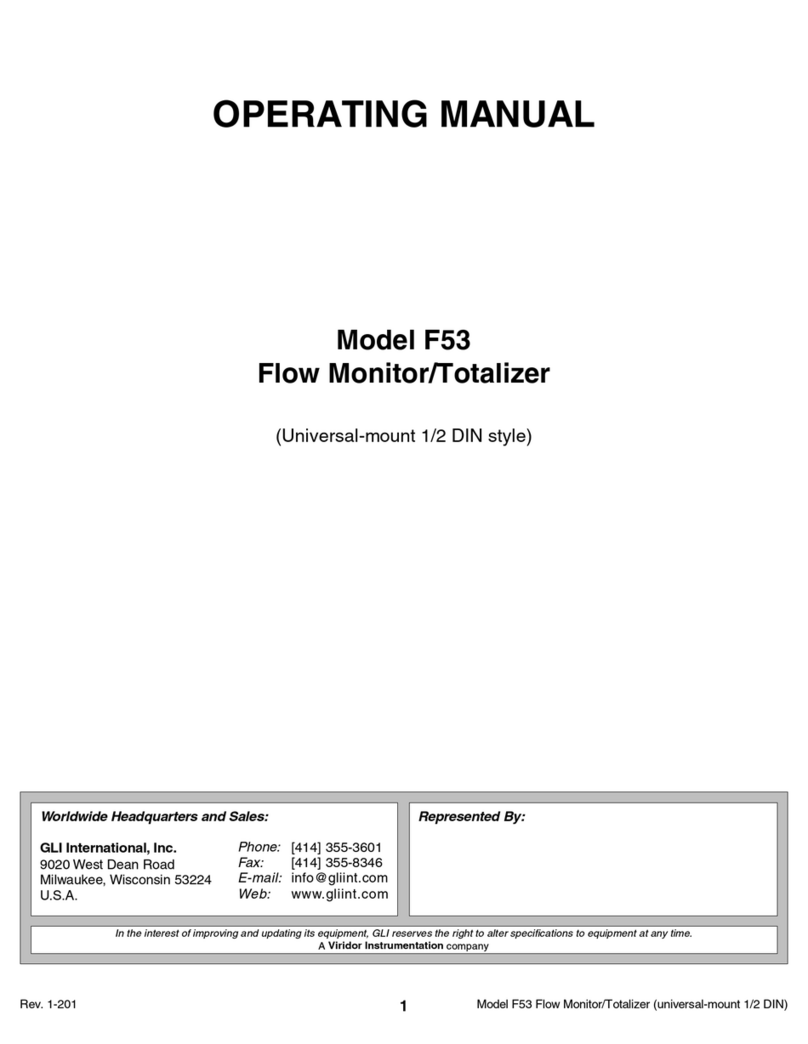
GLI International
GLI International F53 User manual

GLI International
GLI International GLI-98144 User manual

GLI International
GLI International GLI-93711 User manual

GLI International
GLI International C53 Instruction Manual

GLI International
GLI International P53 Instruction Manual

GLI International
GLI International P33 Instruction Manual
